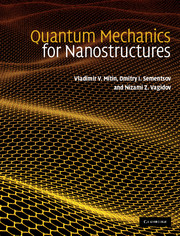Book contents
- Frontmatter
- Contents
- Preface
- List of notation
- 1 The nanoworld and quantum physics
- 2 Wave–particle duality and its manifestation in radiation and particle behavior
- 3 Layered nanostructures as the simplest systems to study electron behavior in a one-dimensional potential
- 4 Additional examples of quantized motion
- 5 Approximate methods of finding quantum states
- 6 Quantum states in atoms and molecules
- 7 Quantization in nanostructures
- 8 Nanostructures and their applications
- Appendix A Classical dynamics of particles and waves
- Appendix B Electromagnetic fields and waves
- Appendix C Crystals as atomic lattices
- Appendix D Tables of units
- Index
7 - Quantization in nanostructures
Published online by Cambridge University Press: 05 June 2012
- Frontmatter
- Contents
- Preface
- List of notation
- 1 The nanoworld and quantum physics
- 2 Wave–particle duality and its manifestation in radiation and particle behavior
- 3 Layered nanostructures as the simplest systems to study electron behavior in a one-dimensional potential
- 4 Additional examples of quantized motion
- 5 Approximate methods of finding quantum states
- 6 Quantum states in atoms and molecules
- 7 Quantization in nanostructures
- 8 Nanostructures and their applications
- Appendix A Classical dynamics of particles and waves
- Appendix B Electromagnetic fields and waves
- Appendix C Crystals as atomic lattices
- Appendix D Tables of units
- Index
Summary
In Chapters 3 and 4 we have discussed electron behavior in potential wells of various profiles and dimensionalities. We have established that localization of electrons in such potential wells, regardless of their form, leads to the discretization of the electron energy spectrum whereby the distance between energy levels substantially depends on the geometrical size of the potential wells. If this size is macroscopic then the distance between the energy levels is so small that we can consider the energy spectrum to be practically continuous (or quasicontinuous). Electrons in metallic samples of macroscopic sizes have this kind of energy spectrum. Another limiting case is that of small clusters consisting of just a few atoms, where the distance between energy levels is of the order of electron-volts. Gradual decrease of one or several geometrical dimensions of the potential well from macroscopic to about 1 μm practically does not change the form of the electron energy spectrum. Very often macroscopic materials (or macroscopic crystals) are referred to as bulk materials or bulk crystals. Changes happen only when the size of structures is of the order of or less than 100 nm. Such structures are called nanostructures. The change of the electron spectrum from quasicontinuous to discrete implies changes in most of the physical properties of nanostructures compared with those in bulk crystals. In this chapter we will consider the main peculiarities of the electron energy spectrum in nanostructures of various dimensionalities.
- Type
- Chapter
- Information
- Quantum Mechanics for Nanostructures , pp. 193 - 257Publisher: Cambridge University PressPrint publication year: 2010



